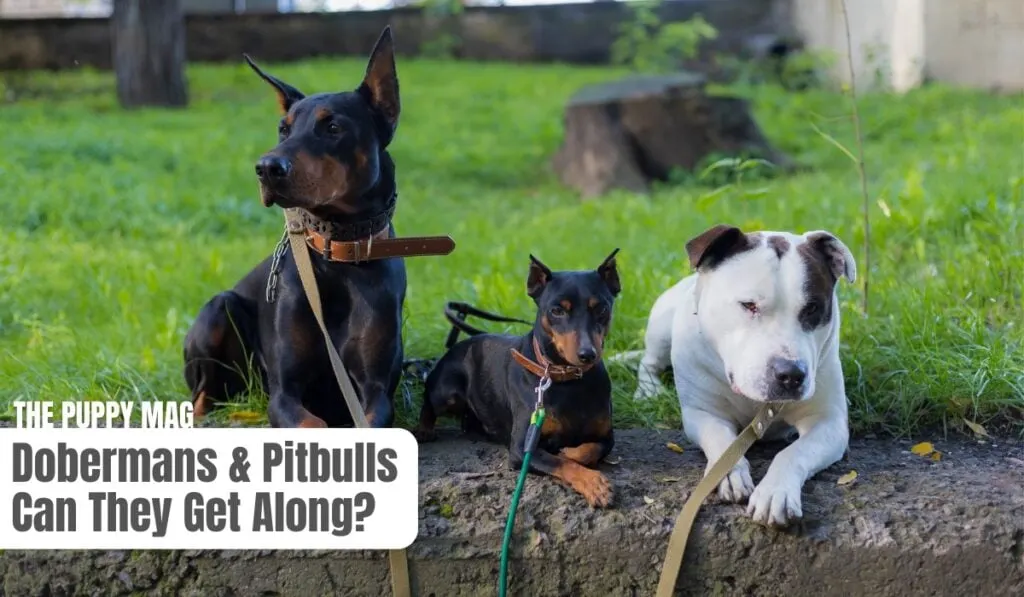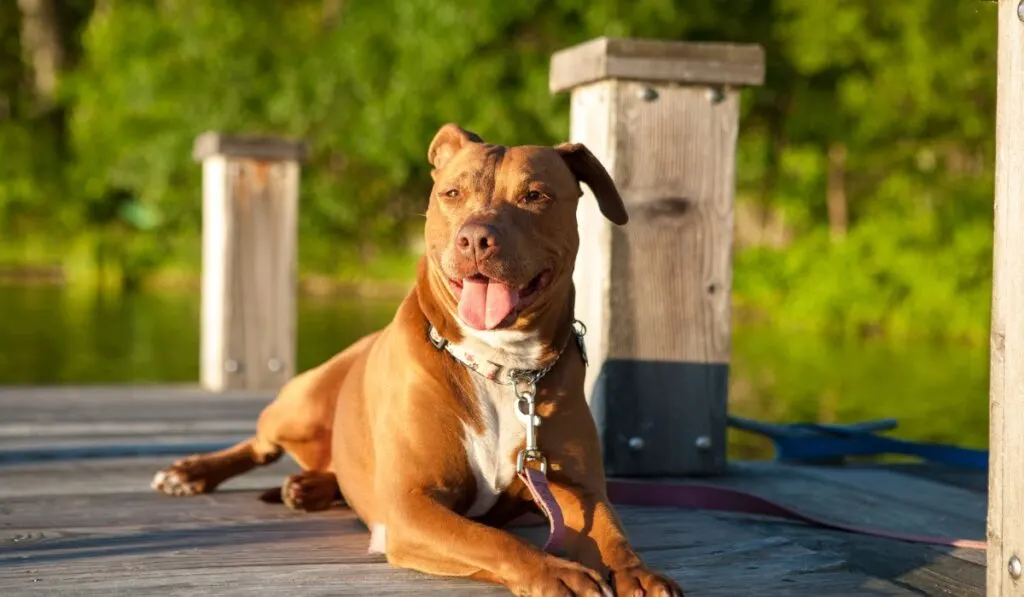Can two fierce and powerful breeds like the Doberman and Pitbull peacefully get along with each other?
I’ll explain absolutely everything you need to know about these two dogs getting on with each other.
The good news is that yes, indeed, Pitbulls can absolutely get along with Dobermans, given the right conditions. Before you bring these two together it’s crucial to read the information below.

The Basics of Pitbulls & Dobermans
To set the stage right, let’s first get to know these two wonderful breeds a little bit better.
Pitbull overview
While the term ‘Pitbull’ is often used to refer to a group of breeds and mixes, the American Pit Bull Terrier is the breed that typically comes to mind. They’re known for their strength, energy, and unwavering loyalty. Although they’ve been unfairly stereotyped as aggressive due to their history as fighting dogs, Pitbulls are actually very affectionate and tend to be great with people when properly socialized.
- Affectionate: Pitbulls are often described as ‘people dogs.’ They are known for their love of human companionship and can form deep bonds with their families.
- Loyal: Pitbulls are known for their unwavering loyalty towards their owners, making them excellent companions.
- Energetic: They are generally high-energy dogs that enjoy playtime and regular exercise.
- Intelligent: Pitbulls are known for their smarts, which can make them both fun to train and a bit mischievous at times.
- Courageous: Originally bred for tough work, Pitbulls can be brave and determined.
Doberman overview
Similarly, Dobermans are often misunderstood because of their imposing stature and history as guard dogs. However, they are typically very loyal, intelligent, and capable of forming deep emotional bonds with their human families. They can be reserved with strangers but are generally very protective and affectionate towards their loved ones.
- Intelligent: Dobermans are renowned for their intelligence. They are fast learners and respond well to training.
- Loyal: Like Pitbulls, Dobermans are incredibly loyal to their families. They often form strong bonds with their owners.
- Protective: Bred as guard dogs, Dobermans are naturally protective and can be wary of strangers, although they are typically non-aggressive unless they perceive a threat.
- Energetic: Dobermans are also high-energy dogs that need regular physical and mental stimulation to keep them happy.
- Sensitive: Despite their tough exterior, Dobermans are known to be sensitive dogs that respond well to positive, gentle training methods.

Can Pitbulls Get Along With Dobermans?
Yes, under the right circumstances a pitbull and a doberman can get along with each other.
We’ll explain how it’s possible, and also highlight the obvious risks involved.
The truth is that any breed can get along with any other breed, so long as they are raised in the correct way.
If both the pitbull and doberman are highly socialized from a young age, then yes, these two dogs will be able to get along just fine.
Socialization is Key ⭐
Regardless of breed, socialization is crucial in ensuring that any dog can get along with others. This means exposing them to a variety of people, places, dogs, and experiences in a positive manner. Both Pitbulls and Dobermans can benefit hugely from early and consistent socialization.
Puppyhood: The best time to start socialization is during puppyhood. Introducing your puppy to different types of people and dogs in a safe, controlled way can help them grow into a confident, friendly adult that have the ability to go up to another dog without being scared or aggressive.
Adulthood: Even if you adopt an adult dog, don’t fret! Socialization can still be achieved. It might take a bit more patience, but with consistency, your furry friend will gradually learn to trust and feel comfortable around other dogs.
➡️ When this relationship might be hard to make work:
If you’re trying to bring either an adult pitbull or doberman into a house with an existing pitbull or doberman, you’ll no doubt have some extreme challenges ahead. Territorial behavior can get in the way of a harmonious relationship in situations like this.
It is still possible, it’ll just be a higher risk situation. Again, assuming both dogs are highly socialized and trained, this can work if they first meet on neutral ground.
➡️ When this relationship can work:
The best chance of this relationship working between these two breeds is when raising the two together from birth OR if they are both highly socialized, trained, and introduced properly.

Why People Think Pitbulls and Dobermans Won’t Get Along
Now, let’s delve into the world of perceptions and misconceptions. Why do some folks scratch their heads when they see a Pitbull and a Doberman getting along like two peas in a pod?
Historical Background
Both Pitbulls and Dobermans have a historical background that has been, in many ways, misunderstood and generalized. Pitbulls were originally bred for bull-baiting and later as fighting dogs, which led to a reputation for aggression. Dobermans, on the other hand, were bred to protect and guard, which can make them seem aloof or overly protective. These historical roles have contributed to stereotypes that persist today.
Media Influence
Unfortunately, both breeds have often been portrayed negatively in the media. Movies and news stories have presented these dogs as aggressive or dangerous breeds, perpetuating misconceptions and fears.
Physical Appearance
The physical attributes of these breeds—muscular bodies, strong jaws (Pitbulls), and cropped ears and docked tails (some Dobermans)—can make them seem more intimidating than they actually are. Their appearance can lead to assumptions about their nature, with people correlating a tough look with a tough demeanor.
Breed Misconceptions
Some believe that certain breeds inherently don’t get along, a misconception likely rooted in the idea that dogs are highly territorial. While dogs are indeed territorial to some extent, their ability to get along with other dogs depends more on their individual temperament, socialization, and training rather than their breed.
Lack of Education
Many people are simply not aware of how crucial socialization and training are for a dog’s behavior. They might attribute a dog’s aggressiveness or inability to get along with other dogs to its breed, rather than considering factors like poor socialization or lack of training.
A lot of reasons to think this won’t work right!
The thing is, those who’ve had the chance to know Pitbulls and Dobermans understand that they’re often affectionate, loyal, and can get along just fine with other dogs, including each other, with proper training and socialization. It’s crucial to look beyond the stereotypes and understand that breed alone does not dictate a dog’s behavior or ability to coexist harmoniously with others.
Meeting and Introduction Techniques
When introducing a Pitbull and a Doberman, certain strategies can help to ensure a positive first impression:
- Neutral Ground: Begin by introducing the dogs in a neutral environment, such as a park. This can help to prevent any territorial behavior.
- Controlled Leash Introduction: Keep both dogs on leashes during their first meeting. This allows for control if one dog reacts unexpectedly.
- Body Language Awareness: Observe the dogs’ body language. Relaxed ears, wagging tails, and play bows are good signs. If you see any signs of tension or aggression, calmly separate them and try again later.
- Take it Slow: Allow the dogs to sniff each other and get acquainted at their own pace. Rushing the process can cause unnecessary stress.
Training and Management
Training can play a pivotal role in fostering a harmonious relationship between a Pitbull and a Doberman.
Positive Reinforcement Training: Use reward-based methods to encourage good behavior. Whenever your dog interacts calmly with the other, offer treats, praises, or favorite toys.
Consistency: Consistency in rules and expectations can create a stable environment for your dogs.
Exercise: Both Pitbulls and Dobermans are high-energy breeds. Ensuring they get plenty of exercise can help to mitigate any potential conflicts stemming from pent-up energy.
Obvious Risks and Considerations
Understanding potential risks when bringing a Pitbull and Doberman together can help you take proactive steps to ensure both dogs can live harmoniously. Let’s delve deeper into these considerations.
Size and Strength Differences:
Pitbulls and Dobermans are both muscular breeds, but Dobermans are typically larger. In play or disagreement, the smaller dog could potentially get injured, even if unintentionally. Therefore, always supervise their interactions, especially in the beginning.
If a fight was to break out between these two dogs it could be extremely difficult and dangerous to intervene and could even lead to a canine fatality.
High Energy Levels:
Both breeds have high energy levels which, if not properly channeled through exercise and mental stimulation, could lead to boisterous play or even fights. Regular exercise, training, and mental stimulation can help keep their energy levels in check and reduce the chances of conflicts.
Prey Drive:
A characteristic often seen in Dobermans is a high prey drive. They were bred to protect and sometimes chase, which can translate into chasing smaller animals. If the Doberman sees the Pitbull or any other dog as prey, this could potentially lead to conflict. However, with appropriate training and socialization, this drive can be managed.
Resource Guarding:
Resource guarding, which is when a dog protects food, toys, or other valued items from others, can potentially cause conflict between any two dogs. It’s important to train your dogs to understand that they don’t need to guard their resources, but rather trust that their needs will be met.
Breed-Specific Legislation and Insurance Issues:
Some regions have breed-specific legislation (BSL) that restricts or bans certain breeds, including Pitbulls and occasionally Dobermans. Additionally, some home insurance policies may have breed restrictions or higher rates for these breeds. Check your local laws and your home insurance policy if applicable.
Health Concerns:
Both Pitbulls and Dobermans are prone to certain breed-specific health issues. While this doesn’t directly affect their relationship, it’s something to keep in mind as health issues can affect a dog’s mood and behavior. Regular vet check-ups and maintaining a healthy lifestyle for both dogs can help manage these potential health concerns.
Individual Differences:
While we’ve focused a lot on the breeds, the individual temperament of each dog will play a significant role in how they get along. Like humans, dogs have their own personalities, which can vary widely even within the same breed. A dog’s past experiences, training, socialization, and general disposition will greatly impact their interactions with other dogs.
Understanding these risks doesn’t mean that a Pitbull and a Doberman can’t live happily together – in fact, many do! By knowing these potential issues, you can be better prepared to navigate them and create a harmonious environment for your dogs.
Can You Make This Work?
Unless you’re highly experienced in handling dogs, confident in the socialization levels of each dog, or raising these two puppies together, then it’s not recommended to try bringing these two dogs together under one roof.
Still, our ultimate answer is that with proper socialization, patient introduction techniques, consistent positive reinforcement training, and a mindful eye on potential risks, your Pitbull and Doberman can not only coexist peacefully but potentially become the best of friends.
So, go ahead, and let them embark on this exciting journey together! After all, a furry friend is indeed a joy forever.
